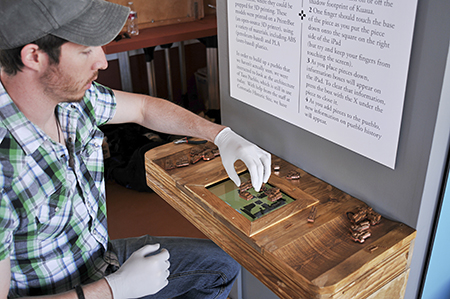
Rick Loffredo/Highlands University
Highlands media arts student Craig Cassidy installs an interactive Build Your Own Pueblo touch screen at the Coronado Historic Site exhibit the students redesigned.
Las Vegas, N.M. – Media arts students at Highlands University used a blend of technology and design to create an interactive exhibit that allows more people to experience Pueblo life circa AD 1300 at the Coronado Historic Site in Bernalillo, New Mexico.
First excavated in the 1930s, the remains of the ancient ancestral village known as Kuaua is one of the first points of contact in New Mexico between Native American civilization and the Francisco Vasquez de Coronado expedition from Spain in 1540-1541.
“The media arts students’ innovative work makes this historic site more accessible to the public through interactive elements like the Build Your Own Pueblo touch screen and an engaging mobile app of exhibit information,” said Ethan Ortega, historian and archaeologist for Coronado Historic Site. “The graphics and design they developed for the exhibit are stunning, drawing you into the story of what it was like to live in the Kuaua village in ancient times. The video blends beautiful imagery, historical photographs, and a well-written script to capture the mystery of the site.”
Ortega said the Coronado Historic Site is a hidden gem in New Mexico and the new exhibit will attract more visitors to the site with the technology elements holding particular appeal for younger audiences.
“The new exhibit will allow the public to digitally explore the site including its Native American and Spanish Colonial artifacts,” Ortega said.
The Coronado Historic Site celebrates its 75th anniversary May 30. It is minutes north of Albuquerque and sits on the banks of the Rio Grande with expansive views of the Sandia Mountains.
“This wonderfully designed and installed exhibit provides a sense of time travel back 1,000 years,” said Richard Sims, director of New Mexico Historic Sites. “I am so delighted with the media arts students’ performance that I’m considering how their many talents could be applied to other historic sites in New Mexico.”
While Coronado was searching for the fabled Seven Cities of Gold, instead he encountered 12 thriving Native American ancestral villages along the Rio Grande River. Today, the descendents of the people of Kuaua village live in the surviving Tiwa-speaking Pueblos of Taos, Pecuris, Sandia and Isleta.
Ortega said when archaeologists excavated the Kuaua village they discovered a different treasure than gold: magnificent and rare murals in a kiva – a subterranean ceremonial chamber. Fourteen of the murals have long been part of the exhibit. They are culturally protected images that may not be replicated and can only be seen at the site.
“This site is part of our history in Northern New Mexico for people of both Native American and Spanish heritage, and it’s important that it not be lost or forgotten,” said Dré Gallegos, media arts graduate student and project manager for the exhibit redesign. “We wanted to preserve and enhance this site to bring the history to life in an inspiring and relatable way.”
Ten students in Highlands’ one-of-a-kind Program for Interactive Cultural Technology, or PICT, created the exhibit. Four other media arts students also worked on the project. Media arts professors Miriam Langer and Kerry Loewen co-taught the PICT class spring semester.
“With PICT the students are trained to become experts in cultural interpretation and presentation,” Langer said.
Loewen said: “My philosophy with a complex project like this is to trust the students including initiating communication with tribal elders in a culturally sensitive way.”
Monica García is in the PICT class and is a member of the Picuris Pueblo.
“As a member of the video team, I was able to identify areas at the Taos Pueblo where filming wouldn’t violate the sacred areas, which was rewarding,” García said.
Taos Pueblo provides a glimpse of what Kuaua village would have looked like when it still stood.
“Not only were we working with a real-world client, which is invaluable, this exhibit project also gave us the opportunity to work with cultural stakeholders to assure that Native American traditions and points of view were respected and represented,” said Shane Flores, the student who wrote the script for the video.
Students in the PICT class who worked on the Coronado Historic Site project include Dré Gallegos, Mario Griego, Natasha Rudolph, Gloria Lovato, Craig Cassidy, Shane Flores, Chris Killion, Monica García, Andrew Shepard, and Jeff Burdick. Other media arts students who worked on the exhibit include Elizabeth Starks, Eli Menchaca, Vishal Bahram and Bresdin O’Malley.
